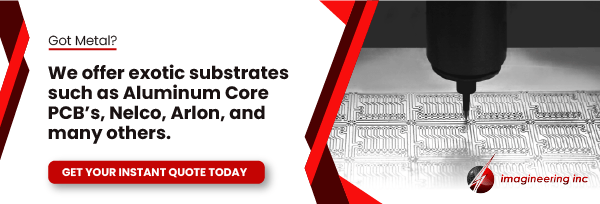Circuit board manufacturing requires careful consideration when it comes to materials, design and functionality. As one of the most common dielectric materials, FR4 is frequently used in a wide variety of PCBs.
There are many reasons why manufacturers prefer FR4 above other options in circuit board fabrication, including structural considerations and cost. Here’s what you need to know about the properties of FR4, when to use it in manufacturing, and when FR4 is not a viable solution.
What is FR4?
In electronics manufacturing, “FR4” is a designation issued by the National Electrical Manufacturers Association (NEMA). FR4 is a flame-retardant material comprised of glass-reinforced epoxy resin. The “4” signifies that the material is made from fiberglass-reinforced epoxy resin. The “FR” stands for “flame retardant” since the material is coated with chemicals that delay or prevent fire from spreading if the component becomes overheated. FR4 includes bromine, and other halogen compounds, which act as flame-retardants. An FR designation means the component adheres to the UL94V-0 standard for flammability.
The glass transition (TG) for FR4 is between 115ºC and 200ºC depending on the manufacture. Standard FR4 has a lower TG of 140ºC to 150ºC, while HighTG FR4 is usually around 180ºC. In PCB manufacturing a thin layer of FR4 is typically laminated with copper foil layers.
What are the Types of FR4?
There are many variations of FR4 used in PCBs. Depending on the requirements for the component functionality, you’ll need to select a specific FR4 material.
Standard FR4 – Standard FR4 has heat resistance of 140ºC to 150ºC, and also has excellent moisture resistance.
High TG FR4 – High TG FR4 is suitable for use in components exposed to higher temperatures. High TG FR4 is able to withstand temperatures of up to 180ºC.
High CTI FR4 – FR4 with high CTI (chemical thermal interaction) has improved conductivity. This material has a Comparative Tracking Index of over 600 volts.
FR4 With No Copper Laminate – FR4 without copper laminate is ideal for insulation and supports. This material is non-conductive and highly durable.
What are the Benefits of FR4 in PCBs?
Manufacturers prefer FR4 in the fabrication of a wide variety of electronic components. Depending on the functional requirements of the circuit board, FR4 is often the most effective and budget-friendly option.
The benefits of FR4 include:
- Low-Cost: FR4 is a relatively low-cost material, making it more economic for many manufacturers creating small-batch PCBs. Since it’s not a huge investment FR4 is frequently used in prototyping.
- Strength to Weight Ratio: FR4 has a high strength-to-weight ratio making it lightweight and durable.
- Low Water Absorption: FR4 has a low water absorption and is therefore a fantastic choice for PCBs that are exposed to moisture, humidity, or used in marine devices.
- Insulating Properties: FR4 is a great insulator due to its dielectric properties.
What are the Drawbacks of FR4 in PCBs?
Although FR4 is a commonly used material, there are several situations in which FR4 is not an ideal material in PCB manufacturing. Elements like heat and high-frequency signals may lead to FR4 deterioration, which affects the integrity of signals and may cause the FR4 to lose insulating properties and become a conductor
Here are a few scenarios when FR4 is not a viable choice:
- High-Temp Environments: If a PCB is being used in a high-temperature application, FR4 is not the best choice. If exposed to intense heat, the insulating elements will decrease and the FR4 will become a conducting element instead. For this reason, FR4 may not be a wise choice to use in aerospace devices.
- Lead-Free Soldering: Some manufacturers require lead-free soldering, which has a higher reflow temperature. Unfortunately, FR4 cannot withstand the high heat, which reaches up to 250ºC.
- High-Frequency Signals: FR4 is not suitable for use in high-speed components. The material isn’t made to withstand high-frequency signals, since it has a variable dielectric constant. Additionally, FR4 has a higher Df (dissipation factor) which leads to compromised signals in high-frequency scenarios.
How to Select the Right FR4 Thickness for Your PCB
If you choose to use FR4 in your circuity project, it’s important to select the right thickness. FR4 PCB thickness ranges from about .2mm to 3.2mm. Depending on the type of product being manufactured, you may need to adjust the FR4 thickness to accommodate elements like size, weight, and flexibility. In general, thinner FR4 is ideal for components that are small, lightweight, and flexible. Thicker FR4 is favored for durability and impedance control.
When to Use Thin FR4 Materials
Thin FR4 materials are ideal for use in smaller components like Bluetooth accessories and USB components. Thinner FR4 is also ideal for designs where space is at a premium and designers want to minimize the amount of space used by the PCB. Additionally, thinner PCBs are preferred in automotive or medical applications, since these scenarios often require components that are more flexible and dynamic. Finally, in some cases the weight of a component is a contributing factor when choosing the FR4 thickness. Lightweight components utilize a thinner FR4 material, which may be ideal for certain applications.
Thin FR4 material is not ideal in scenarios where the board is exposed to high temperatures. Thinner boards are more susceptible to damage from high-heat situations.
When to Use Thick FR4 Materials
In general, manufacturers prefer to find a balance between functionality and thickness. Thicker FR4 materials are more stable, and less likely to be damaged. Thicker FR4 material is ideal for components that feature grooves, since the board has strength and flexibility to withstand the strain. FR4 thickness also determines the impedance control of a board, so a thicker material is preferred in scenarios where impedance control is a key factor.
Creating Unique Circuitry with Imagineering
With so much to learn about PCB materials, designing the ideal circuit board can feel like an intimidating task. If you’re searching for a manufacturer to create high-quality custom circuit boards, Imagineering has your back.
Here at Imagineering, we value customer experience and satisfaction above all else, which is why some of the biggest names in manufacturing choose to work with us. We specialize in rigid and flex double-sided and multilayer circuit boards, and all our boards meet the class-3 standards used in medical and aerospace applications.
The team at Imagineering is committed to providing customers with a positive experience from design to delivery. So what can you expect when you work with us?
- Fast Turnaround Times: We are proud to offer some of the fastest turnaround times in the industry, with same-day prototyping and production in as few as seven days.
- Low Pricing: We believe that you shouldn’t compromise on quality to accommodate your budget. With ties to global suppliers and overseas manufacturing, we offer high-quality PCBs at reasonable prices.
- Hassle-Free Logistics: Some PCB manufacturers outsource elements of the fabrication process. When you work with us, we provide end-to-end services including fabrication, logistics management, and delivery.
- Certifications You Can Trust: Imagineering is proud to be certified to the highest industry standards. We are AS9100D/ISO9001:2015 certified, ITAR registered, SAM registered, WEEE certified, and a member of the ICP to name a few.
It’s time to work with quality you can trust. Contact us today for an initial quote.


